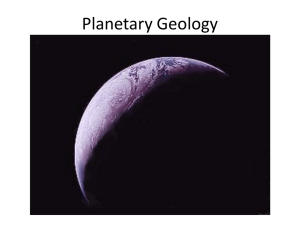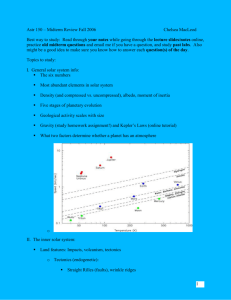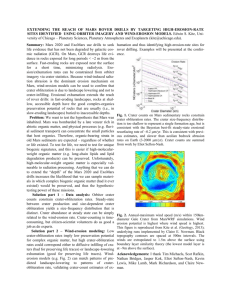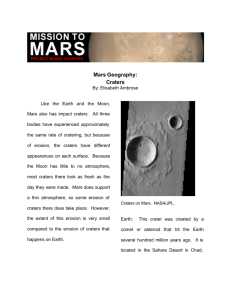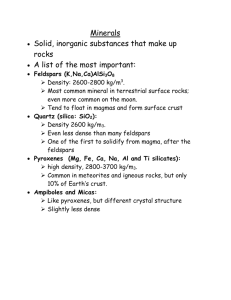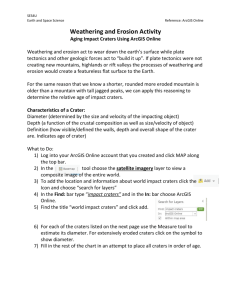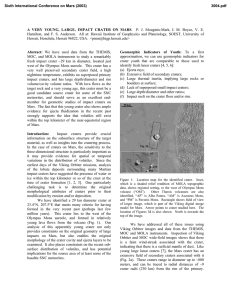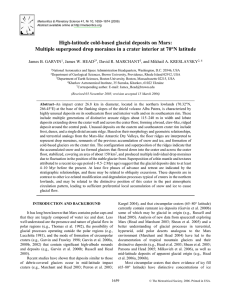notes
advertisement
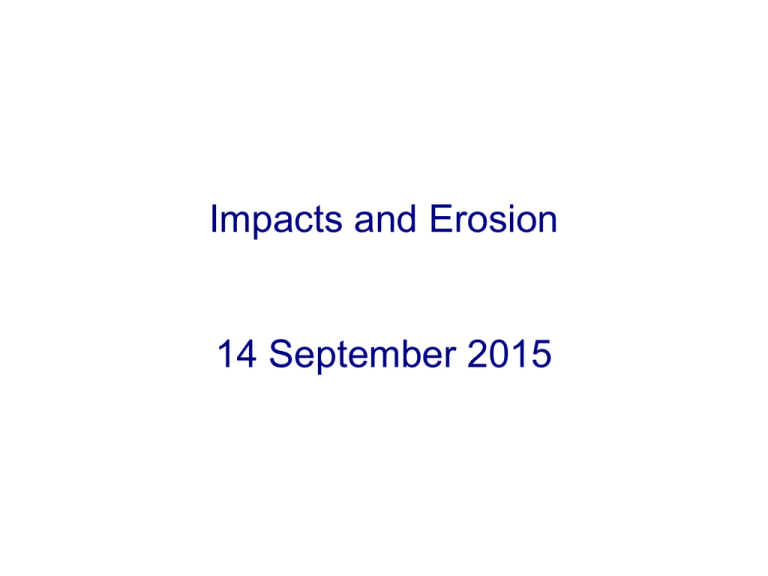
Impacts and Erosion 14 September 2015 Four Basic Geological Processes • Impact cratering – Impacts by asteroids or comets • Volcanism – Eruption of molten rock onto surface • Tectonics – Disruption of a planet’s surface by internal stresses • Erosion – Surface changes made by wind, water, or ice Possible Subduction and Crustal Recycling on Europa Impact Cratering High kinetic energy of impacting object Excavation Heat Shape round for all impact directions Crater Morphology: • Impactor in the inner solar system can have 10s of km/sec relative velocity • May vaporize or liquefy a significant amount of the target for a large impactor • “Simple” craters are bowl shaped • “Complex” craters are flatter, and have a central uplift or peak Impact Craters Tycho (Moon) Meteor Crater (Arizona) The Impact Process 1. Detonation - shockwave propagates through target, projectile vaporized 2. Excavation - target is heated, vaporized, liquified, solid material is ejected (possibly above escape velocity!) 3. Rebound - in larger craters, the target may “bounce back” viscously, forming a central uplift 4. Relaxation - crater walls subside, melt pools in the crater Few Hundred Confirmed Craters on Earth eteor Crater Meteor Crater Ariel view of Meteor Crater Manicouigan Crater Crater Lake Moon’s Giant Basins Moon Near Side Lunar Farside Moon Far Side Lunar Highlands Mare Imbrium Lunar Mare Crater modification Mars Rampart Crater 3 Mars Rampart Crater Venus Craters 1 Ganymede Crater Chain Shoemaker-Levy 9 SL-9 Aftermath Hyperion Hyperion Erosion and Deposition • Erosion and deposition require the presence of a fluid (gas or liquid) to pick up, transport and deposit surface material • Liquid transport more efficient • These processes tend to be rapid compared to other geological processes • So surface appearance is often controlled by these processes • Earth, Mars, Titan, Venus have erosional or sedimentary features Aeolian Features (Mars) • Wind is an important process on Mars at the present day (e.g. Viking seismometers . . .) • Dust re-deposited over a very wide area (so the surface of Mars appears to have a very homogenous composition) • Occasionally get global dust-storms (hazardous for spacecraft) • Rates of deposition/erosion almost unknown Martian dune features Image of a dust devil caught in the act 30km Aeolian features (elsewhere) Namib desert, Earth few km spacing Longitudinal dunes, Earth (to Titan (bottom), ~ 1 km spacin Yardangs (elongated dunes) Mead crater, Venus Wind directions Venus Mars (crater diameter 90m) Wind streaks, Venus Global patterns of wind direction can be compared with general circulation models (GCM’s) Fluvial features • Valley networks on Mars • Only occur on ancient terrain (~4 Gyr old) • What does this imply about ancient Martian atmosphere? 100 km 30 km • Valley network on Titan • Presumably formed by methane runoff • What does this imply about Titan climate and surface? Martian Outflow channels • Large-scale fluvial features, indicating massive (liquid) flows, comparable to ocean currents on Earth • Morphology similar to giant post-glacial floods on Earth • Spread throughout Martian history, but concentrated in the first 1-2 Gyr of Martian history • Source of water unknown – possibly ice melted by volcanic eruptions (jokulhaups)? flow direction 50km 150km Baker (2001) Martian Gullies • A very unexpected discovery (Malin & Edgett, Science 283, 2330-2335, 2000) • Found predominantly at high latitudes (>30o), on polefacing slopes, and shallow (~100m below surface) • Inferred to be young – cover young features like dunes and polygons • How do we explain them? Liquid water is not stable at the surface! • Maybe even active at present day? Lakes Clearwater Lakes Canada ~30km diameters Gusev, Mars 150km Titan, 30km across Titan lakes are (presumably) methane/ethane Gusev crater shows little evidence for water, based on Mars Rover data Erosion • Erosion will remove small, near-surface craters • But it may also expose (exhume) craters that were previously buried • Erosion has recently been recognized as a major process on Mars, but the details are still extremely poorly understood • The images below show examples of fluvial features which have been exhumed channel meander Malin and Edgett, Science 2003 Sediments in outcrop Opportunity (Meridiani) Cross-bedding indicative of prolonged fluid flows
